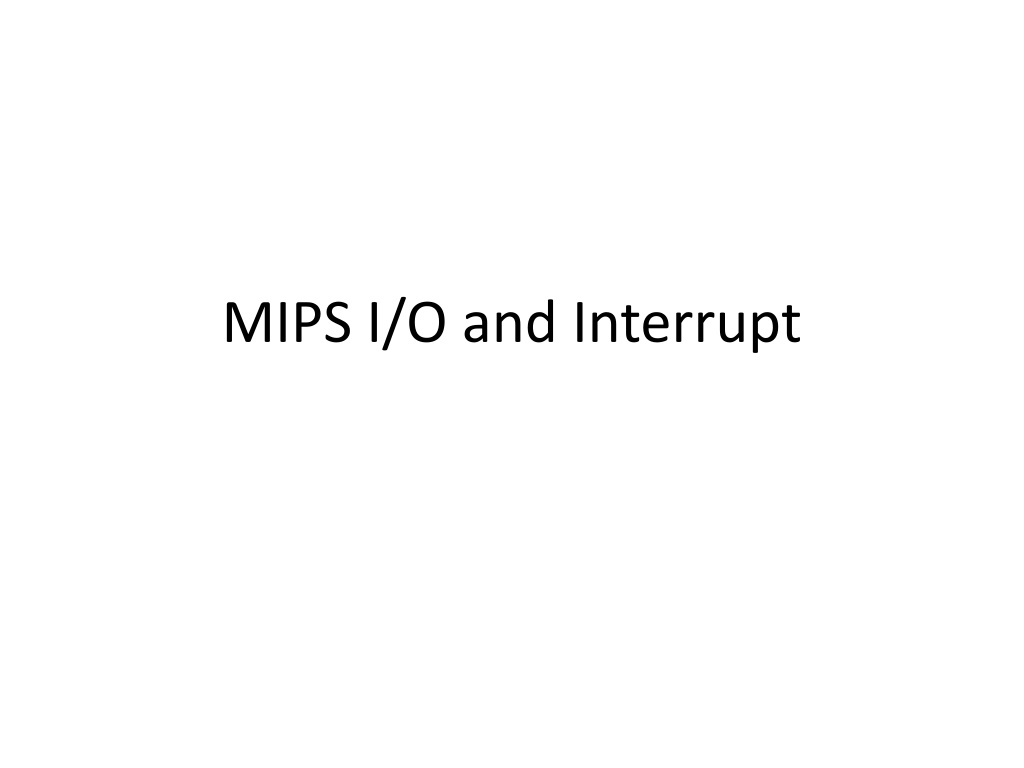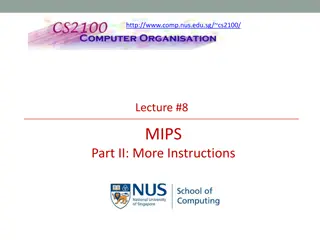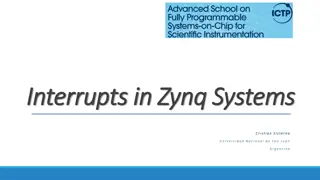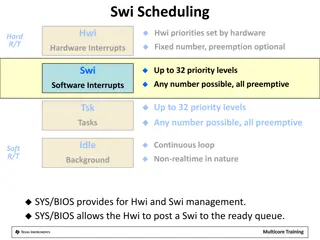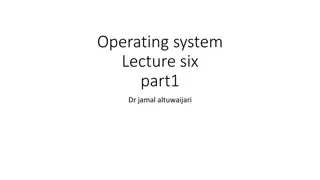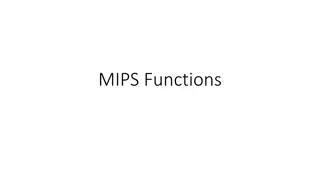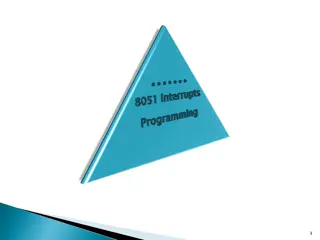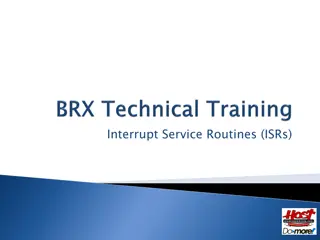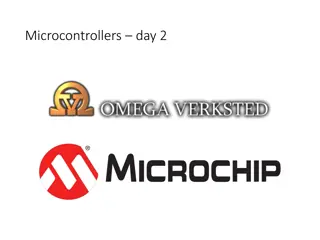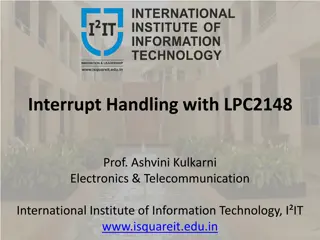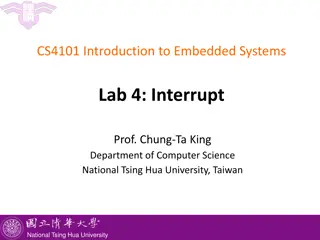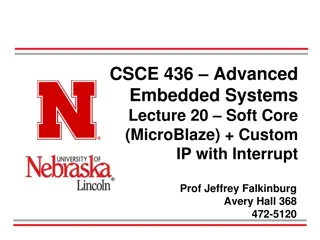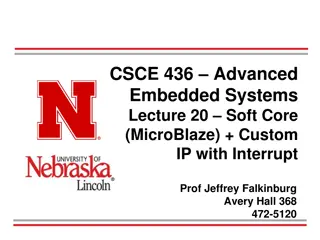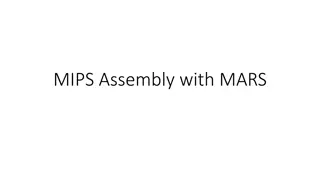Understanding MIPS I/O and Interrupt Handling
Delve into the world of MIPS architecture, exploring how I/O operations and interrupts are managed. Learn about memory organization, system functions, I/O registers, and kernel data. Discover how SPIM facilitates input and output handling, including reading from the keyboard and managing output. Dive into the intricacies of handling interrupts efficiently and the balance between processing tasks and handling unexpected input events.
Download Presentation

Please find below an Image/Link to download the presentation.
The content on the website is provided AS IS for your information and personal use only. It may not be sold, licensed, or shared on other websites without obtaining consent from the author. Download presentation by click this link. If you encounter any issues during the download, it is possible that the publisher has removed the file from their server.
E N D
Presentation Transcript
SPIM I/O and MIPS Interrupts The materials of this lecture can be found in A7-A8 (3rdEdition) and B7-B8 (4thEdition).
The MIPS memory Actually, everything above 0x7fffffff is used by the system.
What is in there? Special operating system functions I/O registers mapped to memory addresses Kernel data
SPIM Input SPIM allows you to read from the keyboard (which is similar to reading something from the true I/O register)
.text .globl main Remember to select Remember to select ``mapped I/O in PCSpim ``mapped I/O in PCSpim settings. settings. To set it, select ``Simulator To set it, select ``Simulator then ``Settings then ``Settings main: waitloop: lw $t1, 0($t0) andi $t1, $t1, 0x0001 beq $t1, $zero, waitloop addi $s0, $0, 113 # q key lui $t0, 0xFFFF # $t0 = 0xFFFF0000; lw $a0, 4($t0) beq $a0, $s0, done li $v0,1 syscall li $v0,4 la $a0, new_line syscall done: j waitloop li $v0, 10 # exit syscall new_line: .asciiz "\n .data
SPIM output Similar to the input, SPIM has two memory locations for output 0xffff0008: Transmitter control. Bit 1: interrupt enable Bit 0: ready 0xffff000c: Transmitter data. Bit 0-7: data byte
SPIM output If you need to show something on the console, do the following: 1. Check if ready bit is 1. If yes, proceed. Otherwise, wait. 2. Write to the data. The ready bit will be reset to 0, and will be set to 1 after the byte is transmitted.
question Is this the most efficient way to do it? Remember that the processor usually has a lot of things to do simultaneously
Interrupt The key problem is that the time when the input occurs cannot be predicted by your program Wouldn t it be nice if you could focus on what you are doing while be interrupted if some inputs come?
MIPS interrupt EPC=0x00000128 EPC= something With external interrupt, if an event happens that must be processed, the following things will happen: The address of the instruction that is about to be executed is saved into a special register called EPC PC is set to be 0x80000180, the starting address of the interrupt handler which takes the processor to the interrupt handler The last instruction of the interrupt should be eret which sets the value of the PC to the value stored in EPC add $t0, $t1, $t0 a a sub $t2, $t1, $t0 a a sub $t0 $s0, $a0 a a a 0x00000128: sll $t0, $t0, 2 a . . . 0x80000180: add $k0, $k1, $k0 a a sub $k1, $k0, $k1 a a eret a a
MIPS Interrupt EPC=0x00000128 EPC= something t0= something t0= 10 t0= 3000 Is it okay to use $t0 in the interrupt? Note the difference between an interrupt and a function call. For a function call, the caller is aware of the function call, so, it is not expecting the value of $t0 to be the same after the call. For an interrupt, the user program is running and gets interrupted. The user program does not know about the interruption at all. So, if you changed $t0 inside an interrupt, after the interrupt returns, the user program will not even be aware of the fact that it has been interrupted, and will use the wrong value of $t0. add $t0, $t1, $t0 a a sub $t2, $t1, $t0 a a sub $t0 $s0, $a0 a a a 0x00000128: sll $t0, $t0, 2 a . . . 0x80000180: add $t0, $k1, $k0 a a sub $t0, $k0, $k1 a a eret a a
Interrupt Interrupt handlers should be short. Usually should just use the interrupt to set some flags, and let the main program to check the flags Flags can be registers and can be checked much faster than reading from the outside
MIPS interrupt Coprocessor 0 is a part of the CPU to handle interrupts. In SPIM, Coprocessor 0 contains the BadVAddr (8), storing the memory address causing the exception Count (9), increment by 1 every 10ms by default Compare (11), if equals to Count, trigger an interrupt of level 5 Status (12), Bit 8-15: interrupt mask. A bit being ``1 means that this interrupt is enabled. Bit 4: user mode. With SPIM, always 1. Bit 1: exception level (EXL). Normally ``0, set to ``1 if an exception occurred. When ``1, no further interrupt is enabled and EPC is not updated. Bit 0: interrupt enable. Enable (``1 ) or disable (``0 ) all interrupts. Cause (13) Bit 8-15: pending interrupts . A bit being ``1 means that this interrupt situation occurred, even if it is not enabled. Bit 2-6: Exception code. ``0 is hardware interrupt. EPC (14) Config (16), config the machine These registers can be read and modified using the instructions mfc0 (move from coprocessor 0) and mtc0 (move to coprocessor 0).
MIPS Interrupt $k0 and $k1 are both used as temporary variables in interrupt servicing routines.
Code we used (Copy and paste it to an editor) .data new_line: .asciiz "\n" main: mfc0 $a0, $12 ori $a0, 0xff11 mtc0 $a0, $12 lui $t0, 0xFFFF ori $a0, $0, 2 sw $a0, 0($t0) li $s6, 10000 li $s7, 10000 .text .globl main # read from the status register # enable all interrupts # write back to the status register # enable keyboard interrupt # $t0 = 0xFFFF0000; # write back to 0xFFFF0000; # $s6 used to pass the ascii code # a large number impossible to be an ascii code loop: beq $s6, $s7, loop ori $a0, $s6, 0 li $v0,1 syscall li $v0,4 la $a0, new_line syscall # print it here. # print the new line mfc0 $t0, $12 andi $t0, 0xfffe mtc0 $t0, $12 # Set Status register # clear ENABLE # write back to status li $s6, 10000 # $s0 used to pass the ascii code mfc0 $t0, $12 ori $t0, 1 mtc0 $t0, $12 # Set Status register # set ENABLE # write back to status j loop
Questions Which of the following statements about the MIPS interrupt mechanism is true? (a) $EPC is created mainly for robustness. The interrupt can actually use $ra to save the return address. (b) It is okay to modify $t0 inside the interrupt because the main program is not expecting $t0 to be unmodified after the interrupt. (c) Both of the above. (d) None of the above.
Questions Suppose a MIPS interrupt handler modifies $at but forgets to restore it before returning. Suppose the interrupt is invoked only once. After it is invoked, which of the following statements is true? (a) The main program will not run correctly. (b) The main program will not run correctly only if the interrupt is invoked during a function call. (c) The main program will run correctly. (d) None of the above.
